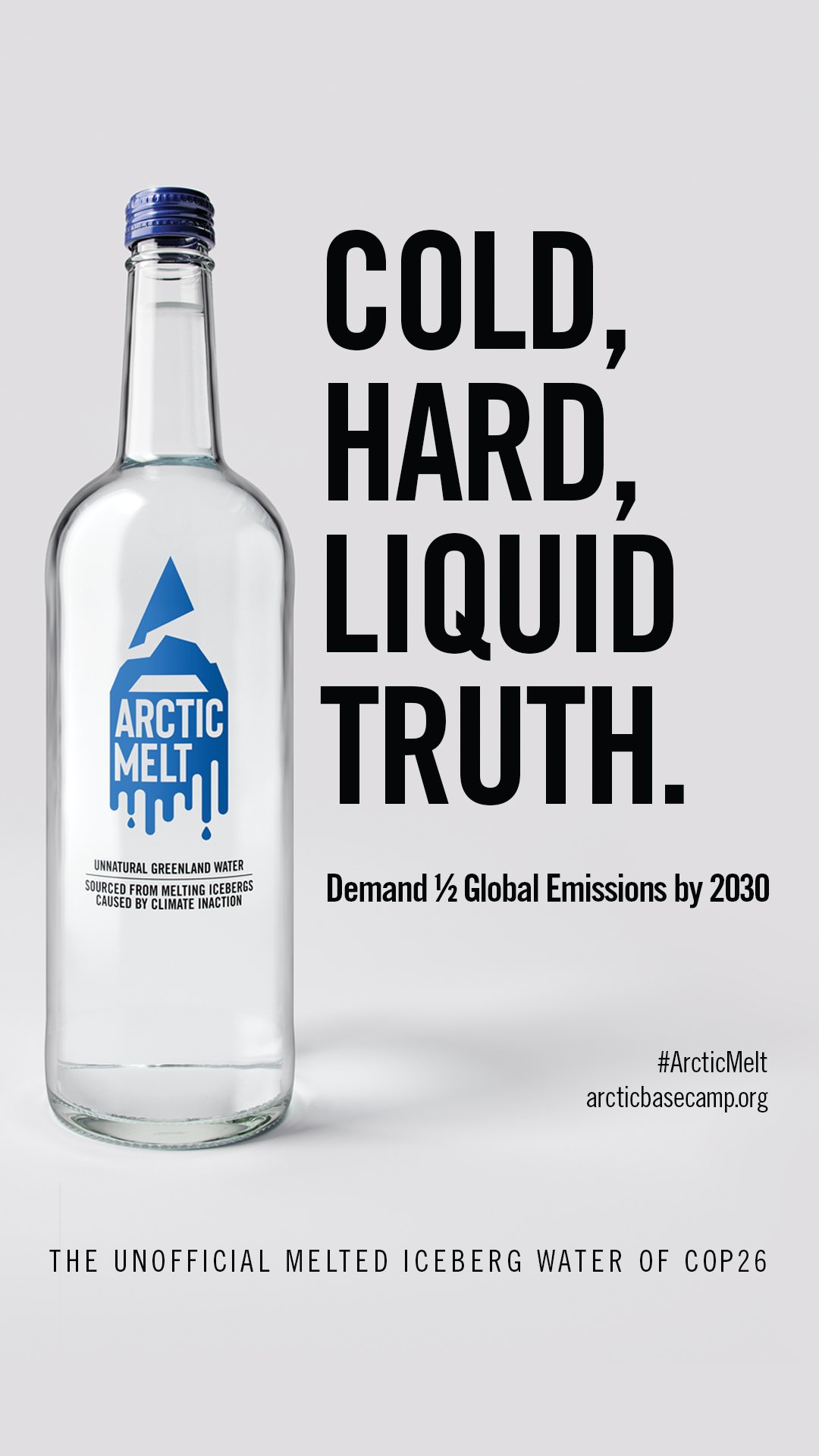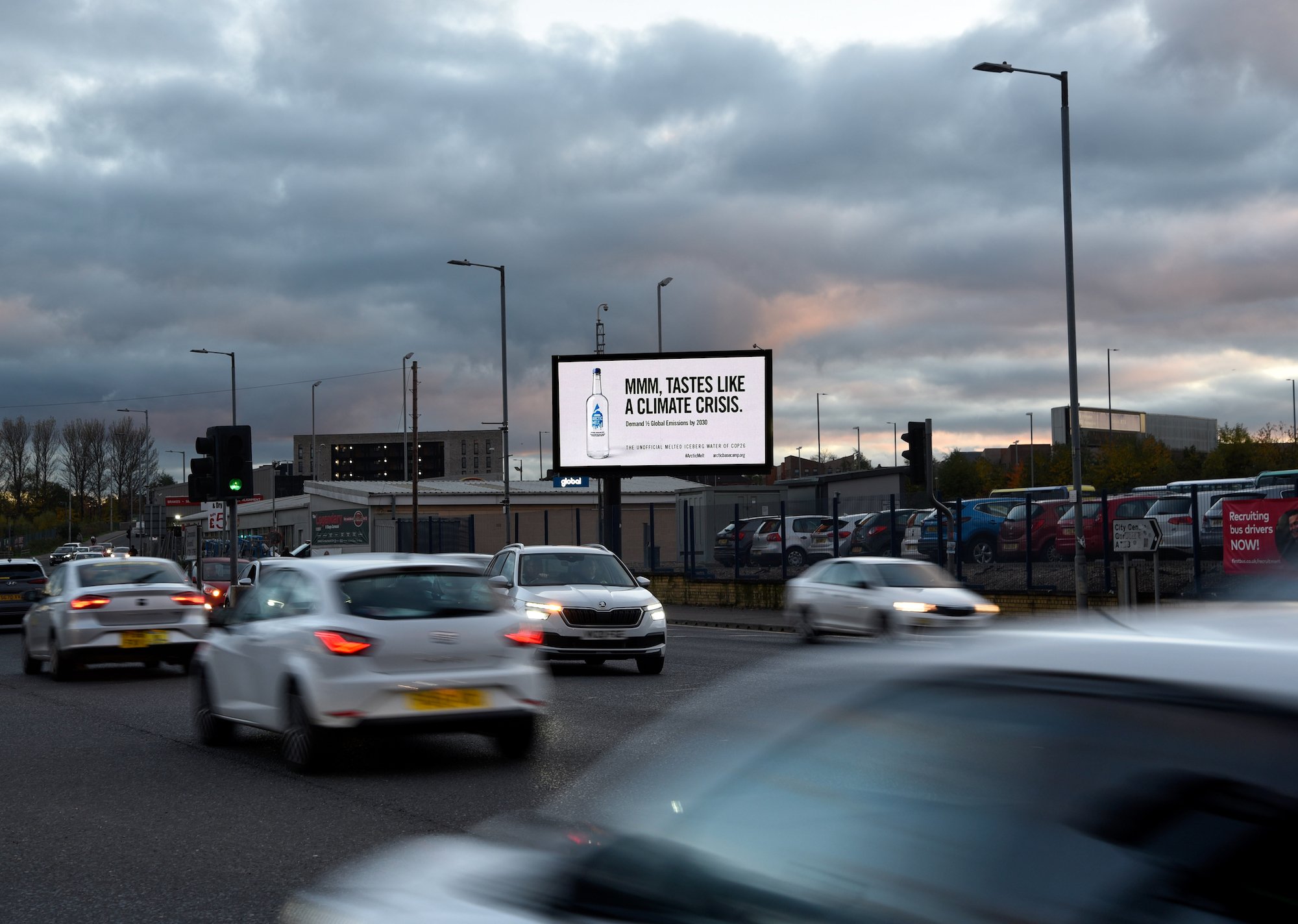A bottle of water. It looks ordinary enough. But take a closer look and you can almost hear the Jaws music start to play…
This is not your average Evian you can pop to the shop and buy (although you’re probably not doing that because of plastic water bottles’ contribution to pollution and global warming). This is a bottle of melted iceberg and it comes with a potent message: the Arctic is melting.
As a matter of fact, on the Greenland ice cap alone, 17 million of these bottles are melting every second.
Over the last 50 years (the equivalent of a nanosecond in the grand scheme of the universe timeline), the Arctic has warmed three times more quickly than the planet as a whole. Widely considered by polar scientists as the Earth's refrigerator due to its role in regulating global temperatures, its own temperature has risen by 3.1 degrees Celsius, compared to 1 degree Celsius for the planet, with each fraction of a degree having a devastating impact. Now imagine we’re the fresh veg inside that fridge…
The "poster child" for the effects of the loss of sea ice on species is the polar bear, a species that could become extinct by 2100 if Arctic ice continues to melt at projected rates. Walruses and arctic foxes are also losing their homes.
But, as climate scientists are fond of saying: "What happens in the Arctic doesn't stay in the Arctic." Rising sea levels will force coastal communities inland, seasonal temperature differences will become more polarised, and extreme weather events will become more frequent, which will in turn lead to a refugee crisis, the likes of which we have not seen before.
Arctic Basecamp is the group that have found themselves taking an unlikely career tangent to water bottling.
They’ve taken these bottles (as well as a four-tonne melting iceberg from Greenland) and set up camp (literally) at a handful of world events such as COP26, the Davos World Economic Forum, and, in a matter of days, Glastonbury. While they’re there, they hand these bottles to key decision makers to make sure that the Arctic has a seat on the table.
This year, they’re taking their melted Arctic message to the mother of all green festivals: Glastonbury. Founded with activism at its heart, it’s the perfect place for Arctic Basecamp to set up shop. If you’re heading to Worthy Farm this week, make sure to stop by and say “Hi”, and speak some science to power. They’ll be located in the “Green Futures” field.

Almost 5,000 kilometres away from Glastonbury Festival, the Arctic and its melting icebergs can sometimes seem distant and abstract. So to bring the polar region and its realities closer to home, Arctic Basecamp has come up with the “Arctic Risk Calculator.” Simply pop in your date of birth and it will tell you precisely by how much temperatures and sea levels have risen since you’ve been alive. Then get a ruler out to see what that sea level rise looks like, or imagine what would happen to the produce in your fridge if you turned it down that many degrees…
We met with Prof. Gail Whiteman, founder of Arctic Basecamp, to find out what it’s like going to the Arctic, what melted Arctic ice water tastes like, and why the Arctic is so important.
Hi Gail, what do you do in a sentence?
I am the Founder of Arctic Basecamp, a not-for-profit science communication platform, and a Professor of Sustainability at the University of Exeter Business School (UK).
Let’s get the important stuff out of the way (joking). Have you been to the Arctic? Do you have to wear special clothing? And what did you eat?
Yes, I’ve been to the Arctic!
You do need to wear special clothes and have special gear. On a research vessel, you have normal gear but also need to know how to use protective clothing in case you fall in the water.
My PhD field work was in the sub-Arctic (just at the top of the treeline) when I lived with Indigenous Peoples in northern Canada for two years — the James Bay Cree.
On a scientific research vessel, the food is actually very good! During my PhD, when I was in the hunting camps, we had to hunt and eat local animals, fish, and in the summer, blueberries.
 An Arctic Basecamp billboard in Glasgow ahead of COP26 in 2021.
An Arctic Basecamp billboard in Glasgow ahead of COP26 in 2021.
OK, now for the actually serious stuff. What is Arctic Basecamp? Why did you start it?
The idea of Arctic Basecamp emerged from a scientific trip through the NorthWest Passage on a Canadian research vessel in 2010. It was so clear then that the sea ice was rapidly disappearing and this would cause severe global risks far away from the Arctic. But no one outside academia or outside the regional geography was concerned about that.
My “task” after that trip was to figure out a way to get this message out of the Arctic and into the discussions of global decision makers. That’s why we set up Arctic Basecamp at the World Economic Forum at Davos. Our mission is to “speak science to power” in order to encourage urgent and transformative climate action. We are a unique science communication platform that tries to convey the science in an understandable way in unusual places. We work with celebrities like Rainn Wilson, who is on our board, business and policy leaders, scientists, NGOs and youth activists — for example, Greta Thunberg camped with us in Davos in 2019. We bring youth climate leaders from around the world each year with us to Davos, including Indigenous youth from the Arctic.
But because we want to reach out beyond the elite crowd at Davos, we have also recently launched the online “Arctic Risk Calculator” which identifies the global risks from Arctic change and helps to curate the data into meaningful “alerts” about climate risks.
Why is the Arctic so important?
The Arctic is the poster child for the need to stay below the +1.5C emissions target, and it’s warming at least three times as fast as the rest of the planet. Climate research shows a strong and direct correlation with rising CO2 emissions and loss of Arctic ice. Science also shows that the Arctic is the barometer of global risk — what happens in the Arctic doesn’t stay there.

A lot of people will know the ice is melting and that’s bad news for polar bears. But what other impacts is it having?
The science is clear — the dramatic changes in the Arctic region are an irrefutable warning sign of the impending global climate emergency. Yet, there remains a significant gap in public awareness and in-depth understanding of the magnitude and breadth of the global risks as a consequence of Arctic change — from extreme weather, storm surges, and global sea level rise, to changes to global precipitation and snowfall patterns. There is also a large disconnect between scientific monitoring of early warning signs of the impending risks from Arctic change and discussions by key global policy makers, business leaders, and local communities and citizens.
Arctic warming can cause extreme weather across the Northern hemisphere. The catastrophic and costly storms, heatwaves, wildfires, and other extreme weather hammering the world’s cities and regions have been linked to changes in the rapidly warming Arctic. Between 2010 and 2019, record-breaking storms, floods, and other natural disasters were the costliest in modern history with losses totaling US$2.98 trillion.
Arctic change will also affect global food and water security because of the central role it plays in the world’s climate system.
Some of the world’s most populated places are on the shores of rising oceans. Seas are rising faster now than over any century in the past 3,000 years. Coastline flooding of low-lying cities and regions as well as devastating coastal erosion will worsen and happen more often in the decades ahead.

Tell me more about the bottled water you took to COP26.
At COP26 in Glasgow, Arctic Basecamp handed out “Arctic Melt” bottles made from real melt water from Greenland. We wanted to put fresh, natural, unadulterated climate facts right under the noses of world leaders, COP26 delegates, climate deniers, and reporters in Glasgow. We brought the Arctic right into the heart of COP26 — “a single serving of alarming climate facts.” Each limited edition bottle contains messages of risk and the advice not to waste these precious glaciers. It was a literal “Bottled Warning” on the need to make bold and ambitious commitments on pledges for emissions reductions and climate action.
How did you actually bottle it?
We worked with Qajak Brewery in Narsaq, a Greenlandic enterprise, to collect Greenland glacial meltwater at source and the water was then bottled by an independent bottler based in Irvine, near Glasgow. It arrived on a ship from Greenland, via Iceland, and transported along with our iceberg to Scotland where Graeme Lindsay from Uisge Source treated the water and bottled it in his factory. All transportation was offset by Ecologi.
What does Arctic water taste like?
It’s very neutral tasting because there are no minerals in it. But I don't know how I feel about actually drinking it. The water can of course be drunk but we hope people see it as a symbol of the climate crisis happening in the Arctic right now.
What was the response like?
People are always astounded to learn that over 17 million bottles of our water melt off the Greenland Ice Sheet per second. That is a lot of meltwater. That's over 13 million litres per second. We also had one global policymaker visit us at COP26 three times!
Why Glastonbury?
We believe that ordinary people have a tremendous amount of power to force politicians and companies to act faster on climate change.
What’s one thing you wish people knew about the Arctic?
That the changes in the Arctic and the Antarctic will determine the fate of humanity.
What gives you hope right now?
Some days, that becomes a really hard question to answer. I had a big dip when I watched Don’t Look Up and felt crushed by the similarity with climate science and the dangerous lack of global action. But eventually I got my hope back because at the end of the day, there is love and there is ingenuity in the world. We can do this! But we have to face the facts and find the courage to make the impossible possible.
Finally, how much have the Arctic temperature and sea levels risen since you’ve been alive?
I was born in 1965 and here are my shocking climate numbers:
- Global temperature rose 1.32 °C | 2.37 °F
- Arctic temperature rose 3.45 °C | 6.22 °F
- Sea level rose 138.60 mm | 5.46 inches
- September Arctic sea ice declined by 53.34 %
- CO2 in atmosphere rose 98.88 ppm | 31.17 %
Global Citizen is partnering with Arctic Basecamp to amplify the call for action to tackle the devastating impact that climate change is having on the Artic, and on vulnerable and marginalized communities around the world. Head over to our Climate Action NOW page and see how many actions you can take today to defend the planet. You can also download the Global Citizen app, and take Challenges that help drive climate action in your own life, and call on world and business leaders to take urgent climate action now.